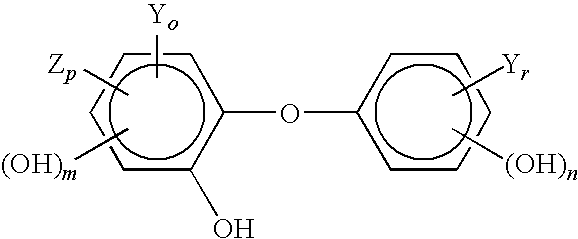Compositions Having a High Antiviral and Antibacterial Efficacy
a technology of antiviral and antibacterial efficacy, applied in the direction of antibacterial agents, biocide, phosphorous compound active ingredients, etc., can solve the problems of high virus infection rate of all mammals, significantly reducing the population of microorganisms, including pathogens, and reducing so as to enhance the persistent antiviral control, reduce the ph of the surface, and without irritating the skin
- Summary
- Abstract
- Description
- Claims
- Application Information
AI Technical Summary
Benefits of technology
Problems solved by technology
Method used
Image
Examples
example 1
[0216]A composition capable of lowering skin pH in accordance with the present invention was prepared by admixing the following ingredients at the indicated weight percentages until homogeneous.
IngredientWeight PercentCitric acid2.1Waterq.s.
[0217]The composition is applied to the skin of an individual in a quantity sufficient to create a surface concentration of at least about 10 micrograms of citric acid per square centimeter of skin surface. The skin pH is reduced from an ambient value of about 5 to 5.5 to an initial value after application of the composition of about 2 to 2.5. The skin is maintained at a pH of less than 3.5 for up to about five hours after application. The skin exhibits an excellent control of viruses and bacteria.
example 2
[0218]This example demonstrates the surprising and unexpected relationship between skin pH and antirhinoviral efficacy. While prior acidic compositions were applied to the skin of the user to provide antiviral, and particularly antirhinoviral, properties, it has been found that simply lowering the skin pH is not sufficient to assure antiviral efficacy. More specifically, to achieve a highly efficacious antiviral efficacy over an extended period of time, such as four hours, the pH of the skin must be maintained at less than 4 for the entire four hours.
[0219]In this example, antirhinoviral activity is assessed 5 minutes after application of an organic acid solution having a pH adjusted over a range of pH values in order to determine the effective pH limits of the compositions. Test solutions containing 1% citric acid and 1% malic acid, each by weight, in aqueous 10% ethanol solvent were prepared. The pH values of the solutions were adjusted by the addition of triethanolamine to provid...
example 3
[0222]The following antirhinoviral composition, which capable of reducing skin pH, was prepared and applied to the fingerpads of human volunteers:
Composition 2DMaterialPercent (by weight)Ethanol70.0Deionized water19.8ULTREZ ® 201)1.0Isopropyl Palmitate1.0Mineral oil1.0DC 200 silicone fluid1.0Cetyl alcohol1.0Citric acid2.0Malic acid2.0GERMABEN II2)1.0Triethanolamine0.05100.01)Acrylate / C10-30 Alkyl Acrylate Crosspolymer;2)Preservative containing propylene glycol, diazolidinyl urea, methylparaben, and propylparaben.
The pH of Sample 2 was 3.1.
[0223]In the test, composition 2D was applied to the fingerpads of all fingers, except the thumbs, of eight volunteers. The thumbs were control sites. The volunteers were divided into fours groups of two each. Each group I-IV then was challenged at a predetermined time with rhinovirus titer on all the fingerpads of each hand to determine the time-dependent efficacy of the test composition. At the time appropriate for each group, the skin pH of the ...
PUM
| Property | Measurement | Unit |
|---|---|---|
| pH | aaaaa | aaaaa |
| temperature | aaaaa | aaaaa |
| pKa | aaaaa | aaaaa |
Abstract
Description
Claims
Application Information
 Login to View More
Login to View More - R&D
- Intellectual Property
- Life Sciences
- Materials
- Tech Scout
- Unparalleled Data Quality
- Higher Quality Content
- 60% Fewer Hallucinations
Browse by: Latest US Patents, China's latest patents, Technical Efficacy Thesaurus, Application Domain, Technology Topic, Popular Technical Reports.
© 2025 PatSnap. All rights reserved.Legal|Privacy policy|Modern Slavery Act Transparency Statement|Sitemap|About US| Contact US: help@patsnap.com



